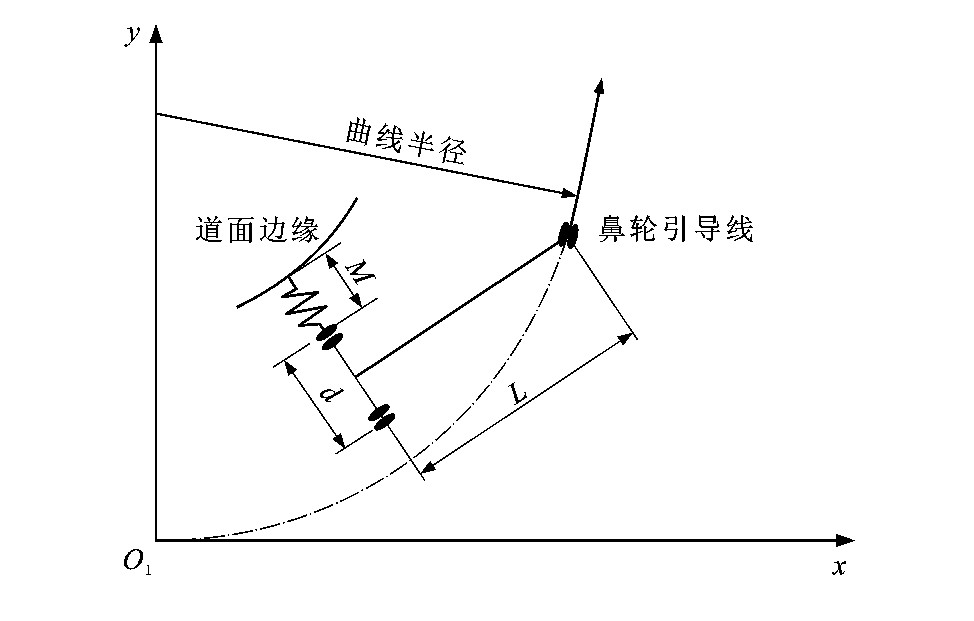New design method of supplemented surface for airport turnoff taxiway
-
摘要: 为了简化机场滑行区弯道增补面设计方法, 依据飞机滑行时起落架轮胎的转弯轮迹, 建立相应的微分方程, 并将飞机滑行轨迹分为鼻轮在圆曲线上行驶和鼻轮驶入直线2段进行求解, 得到了增补面内缘线的解析解; 引入相对纵距、位置系数和表征转弯道面增补面加宽量的增补宽度系数, 分析了转弯道面增补面特征, 基于不同弯道转角与相对纵距下增补宽度系数的相似性, 给出了圆曲线上增补宽度系数的回归方程与直线段开始时飞机纵轴与驶出直线初始夹角的修正式; 结合圆曲线上增补面内缘线的微分方程解提出了机场转弯滑行道增补面设计新方法, 并与ICAO方法进行了对比。计算结果表明: 当弯道转角为135°, 半径为45m, 飞机最大轴距为25m, 主起落架宽度为13m时, 采用新方法计算的最大增补面加宽量为7.52m, 采用ICAO方法计算的最大增补面加宽量为7.53m, 两者差别小于0.2%;采用新方法只需确定弯道的分界点, 便可计算出弯道增补面内缘线任一点的坐标, 但是采用ICAO方法必须求出整个增补面内缘线后才能确定某一增补面内缘点的坐标, 因此, 新方法不仅计算结果满足精度和安全性要求, 而且计算过程简单, 使用方便。Abstract: In order to simplify the design methods of supplemented surface bend on airport, the corresponding differential equation was established based on the turning track of landing gear tire when the plane glided on the runway, the gliding track was divided into two stages to solve the equation: nose wheel driving on the circular curve and nose wheel entering the straight section, and the analytical solution was obtained.The properties of supplemented surface for turning pavement were analyzed by introducing longitudinal space, position coefficient and supplemented width coefficient representing the widening value of supplemented surface for turning pavement.Based on the similarity of fillets width coefficients on different relative longitudinal distances and corner angles, the regression equation of fillets width coefficient was calculated, and the correctional formula of the angle between aircraft and exit line at the beginning of nose wheel entering the straight section was obtained.The new design method of supplemented surface for turning runway was put forward based on the differential equation solution of inner edge of supplemented surface on the circular curve, and was compared with ICAO method.Computationresult shows that when the turning angle is 135°, the curve radius is 45 m, the maximum wheelbase of plane is 25 m, and the width of main landing gear is 13 m, the adding width of supplemented surface calculated by using the new design method is 7.52 m, the value calculated by using ICAO method is 7.53 m, and the difference is less than 0.2%.When the cutoff point of curve is determined, any point coordinates of inner edge line of supplemented surface can be computed by using the new design method, while the inner edge line of supplemented surface must be determined in order to compute any point coordinates by using ICAO method.So, the calculated result of new method meets the precision and safety requirements, the calculation process is simple, and the use is easy.
-
表 1 安全距离
Table 1. Safe distances

表 2 增补面内缘线计算结果
Table 2. Calculation result of inside edge line for supplemented surface

-
[1] TRANI A A, CAO Jin, TARRAGÓM T. Limited study of flight simulation evaluation of high-speed runway exits[J]. Transportation Research Record, 1999(1662): 82-89. [2] 李明捷. 非标准快速出口滑行道平面设计方法研究[J]. 重庆交通大学学报: 自然科学版, 2016, 35(3): 43-46. https://www.cnki.com.cn/Article/CJFDTOTAL-CQJT201603009.htmLI Ming-jie. Graphic design method for the non-standard rapid exit taxiway[J]. Journal of Chongqing Jiaotong University: Natural Science, 2016, 35(3): 43-46. (in Chinese). https://www.cnki.com.cn/Article/CJFDTOTAL-CQJT201603009.htm [3] 种小雷, 王克春, 彭寅, 等. 机场快速出口滑行道平面设计方法[J]. 科技导报, 2013, 31(16): 56-59. doi: 10.3981/j.issn.1000-7857.2013.16.012CHONG Xiao-lei, WANG Ke-chun, PENG Yin, et al. Design of speedy exit runways[J]. Science and Technology Review, 2013, 31(16): 56-59. (in Chinese). doi: 10.3981/j.issn.1000-7857.2013.16.012 [4] 彭寅, 种小雷, 袁俊山, 等. 机场快速出口增补面设计方法[J]. 长安大学学报: 自然科学版, 2012, 32(3): 45-48. doi: 10.3969/j.issn.1671-8879.2012.03.009PENG Yin, CHONG Xiao-lei, YUAN Jun-shan, et al. Design method of supplemented surface on airport's high-speed exit[J]. Journal of Chang'an University: Natural Science Edition, 2012, 32(3): 45-48. (in Chinese). doi: 10.3969/j.issn.1671-8879.2012.03.009 [5] 吴瑞麟. 高等级道路弯道加宽缓和段合理形式的探讨[J]. 中南公路工程, 1993(3): 14-19. https://www.cnki.com.cn/Article/CJFDTOTAL-ZNGL199303003.htmWU Rui-lin. Discuss on high-grade road widening form of curve segments[J]. Central South Highway Engineering, 1993(3): 14-19. (in Chinese). https://www.cnki.com.cn/Article/CJFDTOTAL-ZNGL199303003.htm [6] 潘晓东, 詹嘉, 王富贵. 山区公路小半径曲线加宽及安全设计研究[J]. 公路工程, 2007, 32(6): 4-6, 29. doi: 10.3969/j.issn.1674-0610.2007.06.002PAN Xiao-dong, ZHAN Jia, WANG Fu-gui. Research of curve widen and safe design for mountainous highway with small radius[J]. Highway Engineering, 2007, 32(6): 4-6, 29. (in Chinese). doi: 10.3969/j.issn.1674-0610.2007.06.002 [7] 田勇, 孙佳, 万莉莉, 等. 近距平行跑道间隔确定方法[J]. 交通运输工程学报, 2013, 13(1): 70-76. doi: 10.3969/j.issn.1671-1637.2013.01.011TIAN Yong, SUN Jia, WAN Li-li, et al. Separation determining method of closely spaced parallel runways[J]. Journal of Traffic and Transportation Engineering, 2013, 13(1): 70-76. (in Chinese). doi: 10.3969/j.issn.1671-1637.2013.01.011 [8] 王维, 邓松武. 跑道快速出口优化模型及仿真分析[J]. 中国民航学院学报, 2006, 24(4): 27-31. https://www.cnki.com.cn/Article/CJFDTOTAL-ZGMH200604008.htmWANG Wei, DENG Song-wu. Analysis of optimized runway high-speed exit model and simulation[J]. Journal of Civil Aviation University of China, 2006, 24(4): 27-31. (in Chinese). https://www.cnki.com.cn/Article/CJFDTOTAL-ZGMH200604008.htm [9] WHITE M D, PERFECT P, PADFIELD G D, et al. Acceptance testing and commissioning of a flight simulator for rotorcraft simulation fidelity research[J]. Proceedings of the Institution of Mechanical Engineers Part G: Journal of Aerospace Engineering, 2012, 227(4): 663-686. [10] 张俊. 大型机场快速出口滑行道设计探索[J]. 中国民用航空, 2013(10): 35-36. https://www.cnki.com.cn/Article/CJFDTOTAL-MHJJ201310015.htmZHANG Jun. The design of taxiway with speedy exit for the large airport[J]. China Civil Aviation, 2013(10): 35-36. (in Chinese). https://www.cnki.com.cn/Article/CJFDTOTAL-MHJJ201310015.htm [11] 王维, 曹子路. 民用机场快速出口滑行道位置优化[J]. 中国民航大学学报, 2012, 30(1): 18-22. doi: 10.3969/j.issn.1001-5590.2012.01.005WANG Wei, CAO Zi-lu. Optimization of high-speed runway exit location[J]. Journal of Civil Aviation University of China, 2012, 30(1): 18-22. (in Chinese). doi: 10.3969/j.issn.1001-5590.2012.01.005 [12] 张洪海, 胡明华. 多跑道降落飞机协同调度优化[J]. 交通运输工程学报, 2009, 9(3): 86-91. doi: 10.3321/j.issn:1671-1637.2009.03.017ZHANG Hong-hai, HU Ming-hua. Multi-runway collaborative scheduling optimization of aircraft landing[J]. Journal of Traffic and Transportation Engineering, 2009, 9(3): 86-91. (in Chinese). doi: 10.3321/j.issn:1671-1637.2009.03.017 [13] 冯程, 胡明华, 丛玮. 基于滚动时域算法的航班滑行路径优化模型[J]. 航空计算技术, 2014, 44(4): 80-85. doi: 10.3969/j.issn.1671-654X.2014.04.021FENG Cheng, HU Ming-hua, CONG Wei. Optimization model of taxiway routing based on receding horizon[J]. Aeronautical Computing Technique, 2014, 44(4): 80-85. (in Chinese). doi: 10.3969/j.issn.1671-654X.2014.04.021 [14] CLARE G L, RICHARDS A G. Optimization of taxiway routing and runway scheduling[J]. IEEE Transactions on Intelligent Transportation Systems, 2011, 12(4): 1000-1013. doi: 10.1109/TITS.2011.2131650 [15] BARAHONA F, JENSEN D. Plant location with minimum inventory[J]. Mathematical Programming, 1998, 83(1): 101-111. [16] ATKINS S, WALTON D. Prediction and control of departure runway balancing at Dallas/Fort Worth Airport[C]//IEEE. Proceedings of the 2002American Control Conference. New York: IEEE, 2002: 1308-1313. [17] 罗凤娥. 我国民航机场规划布局的研究[D]. 成都: 西南交通大学, 2003.LUO Feng-e. Research on the national civil airport planning and layout[D]. Chengdu: Southwest Jiaotong University, 2003. (in Chinese). [18] WESOLOWSKI M, BLACHA K. Assessment of load capacity of the airport pavement structure with the use of the ACN-PCNmethod[J]. Research Works of Air Force Institute of Technology, 2015, 35(1): 23-38. [19] 种小雷, 蔡宛彤, 王克春, 等. 基于利用率的机场快速出口位置优化分析[J]. 空军工程大学学报: 自然科学版, 2013, 14(3): 6-9. doi: 10.3969/j.issn.1009-3516.2013.03.002CHONG Xiao-lei, CAI Wan-tong, WANG Ke-chun, et al. Optimization analysis of airfield runway high-speed exit location based on utilization ratio[J]. Journal of Air Force Engineering University: Natural Science Edition, 2013, 14(3): 6-9. (in Chinese). doi: 10.3969/j.issn.1009-3516.2013.03.002 [20] BURNHAM D C, HALLOCK J N, GREENE G C. Wake turbulence limits on paired approaches to parallel runways[J]. Journal of Aircraft, 2002, 39(4): 630-637. [21] 种小雷, 许金良, 蔡良才, 等. 现有机场改建快速出口的可行性分析[J]. 交通运输系统工程与信息, 2010, 10(5): 117-122. https://www.cnki.com.cn/Article/CJFDTOTAL-YSXT201005018.htmCHONG Xiao-lei, XU Jin-liang, CAI Liang-cai, et al. Feasibility analysis of building high-speed exit on existing runway[J]. Journal of Transportation Systems Engineering and Information Technology, 2010, 10(5): 117-122. (in Chinese). https://www.cnki.com.cn/Article/CJFDTOTAL-YSXT201005018.htm [22] YIN Kai, TIAN Chun-yu, WANG B X, et al. Analysis of taxiway aircraft traffic at George Bush Intercontinental Airport, Houston, Texas[J]. Transportation Research Record, 2012(2266): 85-94. [23] ISMAIL N, ISMAIL A, ATIQ R. An overview of expert systems in pavement management[J]. European Journal of Scientific Research, 2009, 30(1): 99-111. [24] LITT J, SOWERS T S, LIU Yuan, et al. Validation of an integrated airframe and turbofan engine simulation for evaluation of propulsion control modes[J]. Quaterly Journal of Economics, 2013, 103(3): 479-508. [25] COETZEE E, KRAUSKOPF B, LOWENBERG M. Analysis of medium-speed runway exit manoeuvres[J]. Journal of Aircraft, 2010, 48(5): 1553-1564. -





 下载:
下载:








